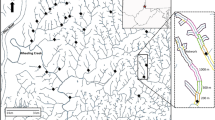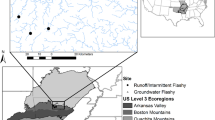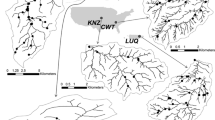Abstract
Stream thalweg depth profiles (along path of greatest channel depth) and woody debris tallies have recently become components of routine field procedures for quantifying physical habitat in national stream monitoring efforts. Mean residual depth, standard deviation of thalweg depth, and large woody debris (LWD) volumes are potential metrics of habitat complexity calculated from these survey data. We used 42 intensive dye-transit studies to demonstrate the relevance of these easily measured channel habitat complexity metrics to transient hydraulic (“dead zone”) storage, a channel process important for biotic habitat as well as retention and “spiraling” of dissolved and particulate nutrients. We examined transient storage and channel morphology in small gravel and cobble-bedded upland streams (wetted width 2–5 m; slopes 2.6–8.3%) representing a wide range of flow stages, LWD loading, and channel complexity, including measurements before and after LWD was added to enhance fish habitat. While transient storage volume fraction decreased as flow stage increased in simple channels, those with complex morphology and well-developed riparian vegetation maintained high transient storage fractions even during storm flows. LWD additions increased transient storage and channel complexity over the 2 years of post-treatment measurements. We predict with considerable precision two different formulations of transient hydraulic storage fraction using single-variable linear regressions on residual depth (R 2 = 0.61–0.89), thalweg depth variance (R 2 = 0.64–0.91), or large woody debris volume (R 2 = 0.48–0.74). Demonstration of these likely causal associations contributes to understanding the process of transient storage and redefines the use of thalweg profile metrics as a new approach to quantifying morphologic and hydraulic complexity in streams.






Similar content being viewed by others
References
Abd El-Hadi, N. D. & K. S. Davar, 1976. Longitudinal dispersion for flow over rough beds. American Society of Civil Engineering Journal of the Hydraulics Division 102: 483–498.
Alvarez, M., L. Proia, A. Ruggiero, F. Sabater & A. Butturini, 2010. A comparison between pulse and constant rate additions as methods for the estimation of nutrient uptake efficiency in-streams. Journal of Hydrology 388: 273–279.
Angermeier P. L. & I. J. Schlosser, 1989. Species-area relationships for stream fishes. Ecology 70: 1450–1462.
Bathurst, J. C., 1981. Bar resistance of gravel-bed streams. American Society of Civil Engineering Journal of the Hydraulics Division 106: 1276–1278.
Bencala, K. E. & R. A. Walters, 1983. Simulation of solute transport in a mountain pool-and-riffle stream: a transient storage model. Water Resources Research 19: 718–724.
Benda, L., M. A. Hassan, M. Church & C. L. May, 2005. Geomorphology of steep headwaters: the transition from hillslopes to channels. Journal of the American Water Resources association (JAWRA) 41: 835–851.
Briggs, M. A., M. N. Gooseff, C. D. Arp & M. A. Baker, 2009. A method for estimating surface transient storage parameters for streams with concurrent hyporheic storage. Water Resources Research 45: W00D27. doi:10.1029/2008WR006959.
Briggs, M. A., M. N. Gooseff, B. J. Peterson, K. Morkeski, W. M. Wollheim & C. S. Hopkinson, 2010. Surface and hyporheic transient storage dynamics throughout a coastal stream network. Water Resources Research 46: W06516. doi:10.1029/2009WR008222.
Calkins, D. & T. Dunne, 1970. A salt tracing method for measuring channel velocities in small mountain streams. Journal of Hydrology 11: 379–392.
Cheong, T. S., B. A. Younis & I. W. Seo, 2007. Estimation of key parameters in model for solute transport in rivers and streams. Water Resources Management 21: 1165–1186. doi:10.1007/s11269-006-9074-7.
Ensign, S. H. & M. W. Doyle, 2005. In-channel transient storage and associated nutrient retention: evidence from experimental manipulations. Limnology and Oceanography 50: 1740–1751.
Fischer, H. B., 1967. The mechanics of dispersion in natural streams. American Society of Civil Engineering, Journal of the Hydraulics Division 93: 187–216.
Fitzpatrick, F. A., I. R. Waite, P. J. D’Arconte, M. R. Meador, M. A. Maupin & M. E. Gurtz, 1998. Revised methods for characterizing stream habitat in the National Water-Quality Assessment Program. U.S. Geological Survey Water-Resources Investigations Report 98-4052: 67 pp.
Gooseff, M. N., J. LaNier, R. Haggerty & K. Kokkeler, 2005. Determining in-channel (dead zone) transient storage by comparing solute transport in a bedrock channel-alluvial channel sequence, Oregon. Water Resources Research 41: W06014. doi:10.1029/2004WR003513.
Gooseff, M. N., J. K. Anderson, S. M. Wondzell, J. LaNier & R. Haggerty, 2006. A modelling study of hyporheic exchange pattern and the sequence, size, and spacing of stream bedforms in mountain stream networks, Oregon, USA. Hydrologic Processes 20: 2443–2457.
Gooseff, M. N., R. O. Hall Jr. & J. L. Tank., 2007. Relating transient storage to channel complexity in streams of varying land use in Jackson Hole, Wyoming. Water Resources Research 43: W01417. doi:10.1029/2005WR004626.
Gooseff, M. N., R. A. Payn, J. P. Zarnetske, W. B. Bowden, J. P. McNamara & J. H. Bradford, 2008. Comparison of in-channel mobile-immobile zone exchange during instantaneous and constant rate stream tracer additions: implications for design and interpretation of non-conservative tracer experiments. Journal of Hydrology 357: 112–124.
Gorman, O. T. & J. R. Karr, 1978. Habitat structure and stream fish communities. Ecology 59: 507–515.
Gucker, B. & I. G. Boechat, 2004. Stream morphology controls ammonium retention in tropical headwaters. Ecology 85: 2818–2827.
Harvey, J. W. & B. J. Wagner, 2000. Quantifying hydrologic interactions between streams and their subsurface hyporheic zones. In Jones, J. B. & P. J. Mulholland (eds), Streams and Ground Waters. Academic Press, San Diego: 3–44.
Harvey, J. W., B. J. Wagner & K. E. Bencala, 1996. Evaluating the reliability of the stream tracer approach to characterize stream-subsurface water exchange. Water Resources Research 32: 2441–2451.
Hays, J. R., 1966. Mass transport mechanisms in open channel flow. Ph.D. Thesis, Vanderbilt University, Nashville, Tennessee: 138 pp.
Heimann, D. C., 1988. Recruitment trends and physical characteristics of coarse woody debris in Oregon Coast Range streams. Master’s Thesis, Department of Forest Engineering/Hydrology, Oregon State University, Corvallis, Oregon: 133 pp.
Hubbard, E. F., F. A. Kilpatrick, L. A. Martens & J. R. Wilson Jr., 1982. Measurement of Time of Travel and Dispersion in Streams by Dye Tracing. Techniques of Water Resources Investigations of the U.S. Geologic Survey, Chapter A9. USGS, Alexandria.
Hughes, R. M., A. T. Herlihy & P. R. Kaufmann, 2010. An evaluation of qualitative indices of physical habitat applied to agricultural streams in ten U.S. states. Journal of the American Water Resources Association 46: 792–806.
Hughes, R. M., P. R. Kaufmann & M. Weber, 2011. National and Regional Comparisons between Strahler Order and Stream Size. Journal of the North American Benthological Society 30: 103–121.
Kaijser, T., 1971. A stochastic model describing the water motion in a river. Nordic Hydrology II 2: 243–265.
Kasahara, T. & A. R. Hill, 2006a. Effects of riffle-step restoration on hyporheic zone chemistry in N-rich lowland streams. Canadian Journal of Fisheries and Aquatic Sciences 63: 120–133.
Kasahara, T. & A. R. Hill, 2006b. Hyporheic exchange flows induced by constructed riffles and steps in lowland streams in southern Ontario, Canada. Hydrologic Processes 20: 4287–4305.
Kasahara, T. & S. M. Wondzell, 2003. Geomorphic controls on hyporheic exchange flow in mountain streams. Water Resources Research 39(1): 1005. doi:10.1029/2002WR001386.
Kaufmann, P. R., 1987a. Channel morphology and hydraulic characteristics of torrent-impacted forest streams in the Oregon Coast Range, U.S.A., Ph.D. Dissertation, Department of Forest Engineering/Hydrology, Oregon State University, Corvallis, OR.
Kaufmann, P. R., 1987b. Slackwater habitat in torrent-impacted streams. In: Beschta, R. L., T. Blinn, G. E. Grant, F. J.Swanson, G. E. Ice (eds), Erosion and Sedimentation in the Pacific Rim. International Association of Hydrologic Science, Pub. No. 165. Proceedings of an International Symposium, August 3–7, 1986. Oregon State University, Corvallis: 407–408.
Kaufmann, P. R. (ed.), 1993. Physical habitat. In: Hughes, R. M. (ed.), Stream Indicator and Design Workshop. EPA/600/R-93/138. U.S. Environmental Protection Agency, Office of Research and Development, Corvallis, Oregon: pp 59–69.
Kaufmann, P. R., P. Levine, E. G. Robison, C. Seeliger, & D. V. Peck, 1999. Quantifying Physical Habitat in Wadeable Streams. EPA/620/R-99/003. U.S. Environmental Protection Agency, Washington, DC [available on internet at http://www.epa.gov/emap/html/pubs/docs/groupdocs/surfwatr/field/phyhab.html]. Accessed in October 2006.
Kaufmann, P. R., J. M. Faustini, D. P. Larsen & M. A. Shirazi, 2008. A roughness-corrected index of relative bed stability for regional stream surveys. Geomorphology 99: 150–170.
Keim, R. F., A. E. Skaugset & D. S. Bateman, 2002. Physical aquatic habitat II. Pools and cover affected by large woody debris in three western Oregon streams. North American Journal of Fisheries Management 22: 151–164.
Keller, E. A. & F. J. Swanson, 1979. Effects of large organic material in channel form and fluvial processes. Earth Surface Processes 4: 361–380.
Lamberti, G. A., S. V. Gregory, L. R. Ashkenas, R. C. Wildman & A. D. Steinman, 1989. Influence of channel geomorphology on retention of dissolved and particulate matter in a Cascade Mountain stream. USDA Forest Service General Technical Report PSW-110.
LeGrand-Marqu, C. & H. Laudelout, 1985. Longitudinal dispersion in a forest stream. Journal of Hydrology 78: 317–324.
Lisle, T. E., 1982. Effects of aggradation and degradation on riffle-pool morphology in natural gravel channels, northwestern California. Water Resources Research 18: 1643–1651.
Lisle, T. E., 1987. Using “Residual Depths” to Monitor Pool Depths Independently of Discharge. USDA Forest Service Pacific. SW Forest and Range Exper. Sta. Research Note PSW-394. 4 pp.
Lisle, T. E. & S. Hilton, 1992. The volume of fine sediment in pools: an index of sediment supply in gravel-bed streams. Water Resources Bulletin 28: 371–383.
Madej, M. A., 1999. Temporal and spatial variability in thalweg profiles of a gravel-bed river. Earth Surface Processes and Landforms 24: 1153–1169.
Madej, M. A., 2001. Development of channel organization and roughness following sediment pulses in single-thread, gravel bed rivers. Water Resources Research 37: 2259–2272.
McMahon, T. E. & G. F. Hartman, 1989. Influence of cover complexity and current velocity on winter habitat use by juvenile Coho salmon (Oncorhynchus kisutch). Canadian Journal of Fisheries and Aquatic Sciences 46: 1551–1557.
Moore, K. M. & S. V. Gregory, 1988. Summer habitat utilization and ecology of cutthroat trout fry (Salmo clarki) in Cascade mountain streams. Canadian Journal of Fisheries and Aquatic Sciences 45: 1921–1930.
Morrice, J. A., H. M. Valett, C. N. Dahm & M. E. Campana, 1997. Alluvial characteristics, groundwater-surface water exchange and hydrological retention in headwater streams. Hydrologic Processes 11: 253–267.
Mossop, B. & M. J. Bradford, 2006. Using thalweg profiling to assess and monitor juvenile salmon (Oncorhynchus spp.) habitat in small streams. Canadian Journal of Fisheries and Aquatic Sciences 63: 1515–1525.
O’Conner, B. L., M. Hondzo & J. W. Harvey, 2010. Predictive modeling of transient storage and nutrient uptake: implications for stream restoration. Journal of Hydraulic Engineering 136(12): 1018–1032.
O’Neill, M. P. & A. D. Abrahams, 1984. Objective identification of pools and riffles. Water Resources Research 20: 921–926.
Orr, C. H., J. J. Clark, P. R. Wilcock, J. C. Finlay & M. W. Doyle, 2009. Comparison of morphological and biological control of exchange with transient storage zones in a field-scale flume. Journal of Geophysical Research 114: G02019. doi:10.1029/2008JG000825.
Paulsen, S. G., A. Maio, D. V. Peck, J. L. Stoddard, E. Tarquinio, S. M. Holdsworth, J. Van Sickle, L. L. Yuan, C. P. Hawkins, A. T. Herlihy, P. R. Kaufmann, M. T. Barbour, D. P. Larsen & A. R. Olsen, 2008. Condition of stream ecosystems in the US: an overview of the first national assessment. Journal of the North American Benthological Society 27: 812–821.
Payn, R. A., M. N. Gooseff, D. A. Benson, O. A. Cirpka, J. P. Zarnetske, W. B. Bowden, J. P. McNamara & J. H. Bradford, 2008. Comparison of instantaneous and constant-rate stream tracer experiments through non-parametric analysis of residence time distributions. Water Resources Research 44: W06404. doi:10.1029/2007WR006274.
Pearsons, T. N. & G. M. Temple, 2007. Impacts of early stages of salmon supplementation and reintroduction programs on three trout species. North American Journal of Fisheries Management 27: 1–20.
Pearsons, T. N. & G. M. Temple, 2010. Changes to Rainbow Trout abundance and salmonid biomass in a Washington watershed as related to hatchery salmon supplementation. Transactions of the American Fisheries Society 139: 502–520.
Pearsons, T. N., H. W. Li & G. A. Lamberti, 1992. Influence of habitat complexity on resistance to flooding and resilience of stream fish assemblages. Transactions of the American Fisheries Society 121: 427–436.
Peck, D. V., A. T. Herlihy, B. H. Hill, R. M. Hughes, P. R. Kaufmann, J. Klemm, J. M. Lazorchak, F. H. McCormick, S. A. Peterson, P. L. Ringold, T. Magee & M. Cappaert, 2006. Environmental Monitoring and Assessment Program-Surface Waters Western Pilot Study: Field Operations Manual for Wadeable Streams. EPA/620/R-06/003. U.S. Environmental Protection Agency, Office of Research and Development, Washington, DC.
Pedersen, F. B., 1977. Prediction of Longitudinal Dispersion in Natural Streams. Series Paper 14. Institute of Hydrodynamics and Hydraulic Engineering, Technical University of Denmark: 69 pp.
Poff, N. L. & J. V. Ward, 1989. Implications of streamflow variability and predictability for lotic community structure: a regional analysis of streamflow patterns. Canadian Journal of Fisheries and Aquatic Sciences 46: 1805–1818.
Richter, B., J. V. Baumgartner, J. Powell & D. P. Braun, 1996. A method for assessing hydrologic alteration within ecosystems. Conservation Biology 10: 1163–1174.
Robison, E. G. & P. R. Kaufmann, 1994. Evaluating two objective techniques to define pools in small streams. In Marston, R. A. & V. A. Hasfurther (eds), Effects of Human Induced Changes on Hydrologic Systems. Summer Symposium Proceedings. American Water Resources Association, June 26–29, 1994, Jackson Hole, Wyoming: 1182 pp.
Runkel, R. L., 1998. One dimensional transport with inflow and storage (OTIS): a solute transport model for streams and rivers. U.S. Geological Survey Water-Resources Investigation Report 98-4018. U.S. Geological Survey, Denver, Colorado [available on internet at http://co.water.usgs.gov/otis].
Runkel, R. L., 2002. A new metric for determining the importance of transient storage. Journal of the North American Benthological Society 21: 529–543.
Runkel, R. L. & S. C. Chapra, 1993. An efficient numerical solution of the transient storage equations for solute transport in small streams. Water Resources Research 29: 211–215.
Sabol, G. V. & C. F. Nordin Jr., 1978. Dispersion in rivers as related to storage zones. American Society of Civil Engineering Journal of the Hydraulics Division 104: 695–708.
Stack, W. R. & R. L. Beschta, 1989. Factors influencing pool morphology in Oregon coastal streams. In: Woessner, W. W. & D. F. Potts (eds), Headwaters Hydrology Symposium. American Water Resources Association: 708 pp.
Stoddard, J. L., D. V. Peck, S. G. Paulsen, J. Van Sickle, C. P. Hawkins, A. T. Herlihy, R. M. Hughes, P. R. Kaufmann, D. P. Larsen, G. Lomnicky, A. R. Olsen, S. A. Peterson, P. L. Ringold & T. R. Whittier, 2005a. An Ecological Assessment of Western Streams and Rivers. EPA 620/R-05/005. U.S. Environmental Protection Agency, Washington, DC.
Stoddard, J. L., D. V. Peck, A. R. Olsen, D. P. Larsen, J. Van Sickle, C. P. Hawkins, R. M. Hughes, T. R. Whittier, G. Lomnicky, A. T. Herlihy, P. R. Kaufmann, S. A. Peterson, P. L. Ringold, S. G. Paulsen & R. Blair, 2005b. Environmental Monitoring and Assessment Program Western Streams and Rivers Statistical Summary. EPA 620/R-05/006. U.S. Environmental Protection Agency, Washington, DC.
Stofleth, J. M., F. D. Shields Jr. & G. A. Fox, 2008. Hyporheic and total transient storage in small, sand-bed streams. Hydrologic Processes 22: 1885–1894.
Thackson, E. L. & K. B. Schnelle Jr., 1970. Predicting effects of dead zones on stream mixing. American Society of Civil Engineering Journal of the Sanitary Engineering Division 96: 319–331.
Thorp, J. H., M. C. Thoms & M. D. DeLong, 2006. The riverine ecosystem synthesis: biocomplexity in river networks across space and time. River Research and Applications 22: 123–147.
United States Environmental Protection Agency, 2006. Wadeable Streams Assessment: A Collaborative Survey of the Nation’s Streams. EPA-841-B-06–002. United States Environmental Protection Agency, Office of Water, Washington, DC.
Valentine, E. M. & I. R. Wood, 1979a. Experiments in longitudinal dispersion with dead zones. American Society of Civil Engineering Journal of the Hydraulics Division 105: 999–1016.
Valentine, E. M. & I. R. Wood, 1979b. Dispersion in rough rectangular channels. American Society of Civil Engineering Journal of the Hydraulics Division 105: 1537–1553.
Wagner, B. J. & J. W. Harvey, 1997. Experimental design for estimating parameters of rate-limited mass transfer: analysis of stream tracer studies. Water Resources Research 33: 1731–1741.
Wolter, C. & A. Sukhodolov, 2008. Random displacement versus habitat choice of fish larvae in rivers. River Research and Applications 24: 661–672.
Wondzell, S. M., 2006. Effect of morphology and discharge on hyporheic exchange flows in two small streams in the Cascade Mountains of Oregon, USA. Hydrologic Processes 20: 267–287.
Acknowledgments
The research presented in this manuscript was undertaken at the U.S. EPA’s Western Ecology Division of the National Health and Environmental Effects Laboratory in Corvallis, OR, funded by the USEPA in support of developing indicators for monitoring the condition of aquatic resources through the National Aquatic Resource Surveys (NARS). Hydraulic dye transport data were collected and analyzed by the lead author in 1983–1986, with Ph.D research support from the Oregon State University Department of Forest Engineering (advisor: Bob Beschta) and a fellowship from the Weyerhauser Corporation. We are grateful to Tony Olsen, Steve Paulsen, Sarah Lehman, and Susan Holdsworth for funding and program support. We thank Chris Jordan, Bob Ozretich, John VanSickle, Steve Wondzell, Jordan Rosenfeld, and an additional anonymous reviewer for comments on earlier drafts. This manuscript has been subjected to review by the National Health and Environmental Effects Research Laboratory’s Western Ecology Division and approved for publication. Approval does not signify that the contents reflect the views of the Agency, nor does mention of trade names or commercial products constitute endorsement or recommendation for use.
Author information
Authors and Affiliations
Corresponding author
Additional information
Guest editors: K. E. Kovalenko & S. M. Thomaz / The importance of habitat complexity in waterscapes
Rights and permissions
About this article
Cite this article
Kaufmann, P.R., Faustini, J.M. Simple measures of channel habitat complexity predict transient hydraulic storage in streams. Hydrobiologia 685, 69–95 (2012). https://doi.org/10.1007/s10750-011-0841-y
Received:
Accepted:
Published:
Issue Date:
DOI: https://doi.org/10.1007/s10750-011-0841-y




